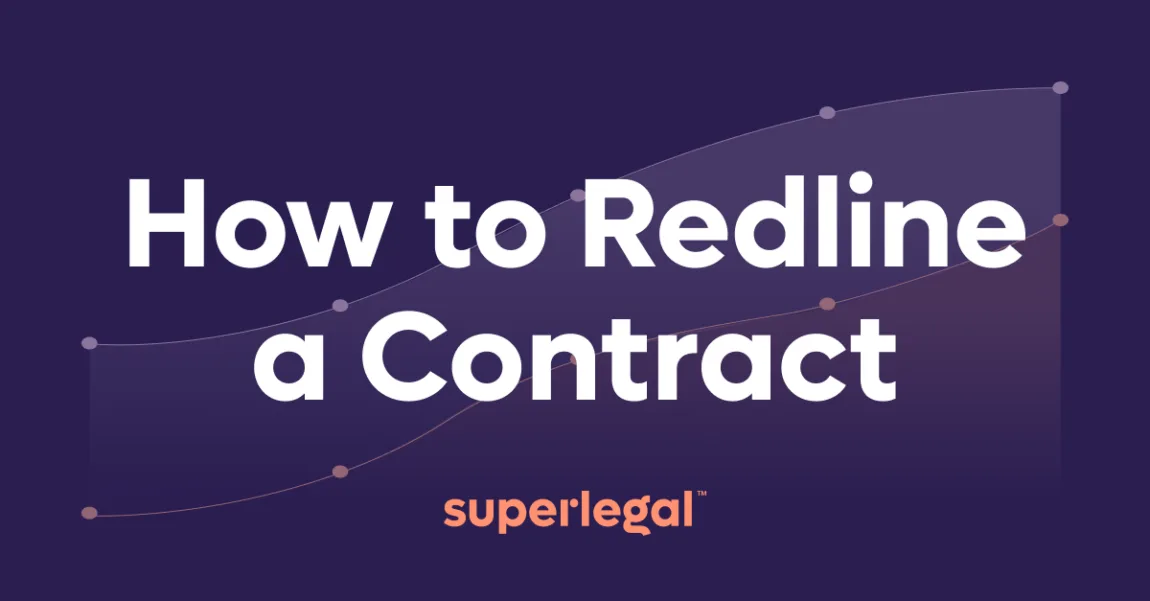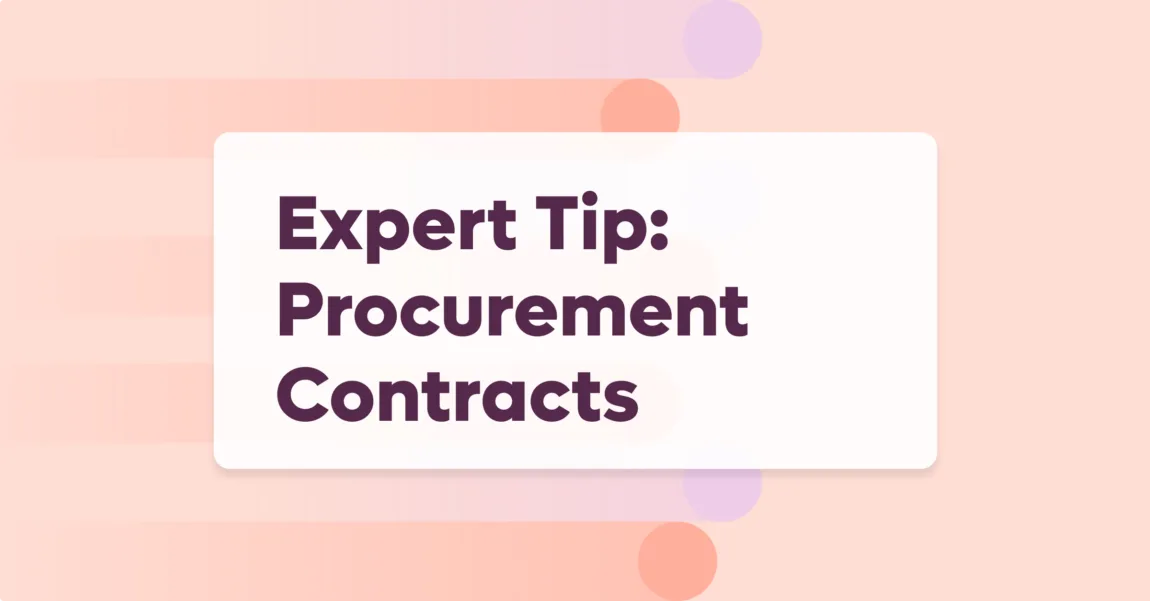These days, commercial contracts are very rarely signed as-is, your Apples and your Googles may expect contracts to be signed without question, but the terms of most B2B contracts are negotiable.
At its core, redlining is a process designed to speed up the time to signature and eliminate the need for lengthy negotiation meetings.
Tracking changes to a document in the form of ‘redlines’ ensures that collaborators can quickly identify the issues that require a conversation, and work to resolve them.
Redlining is so much more than just editing.
It’s a collaborative process where every party involved in the contract works together to produce a document that concludes the negotiations, aligns the parties and determines the rules governing the contractual relationship.

What does redlining a contract mean?
Contract redlining is one of the most commonly used negotiation techniques in business.
People have been redlining contracts long before computers and computer software were around to make the process easy and efficient.
In fact, the term “red line” literally refers to the markings that a person would make by hand using a red pen when they reviewed changes to a contract or other legal document.
The person conducting the contract review would use a ruler and a red pen to indicate edits to the document. Deleted text was marked with a single strike-through line and inserted text was marked with a double line.
What are redlines in contracts?
Redlines are the terms that the reviewing party would like to amend, either by removing the term, editing the term, or inserting an entirely new term altogether.
All edits and changes made to the contract are considered to be ‘redlines’ and are reflected as track changes in red on the electronic version of the contract, with changes made in Word, Adobe or another software program.

What is a redlined contract?
A redlined contract is a contract that contains redline edits during the process of the negotiation.
A contract is a redlined contract if it contains any redline track changes whatsoever.
The redlines indicate that the contract is still in the process of negotiation and not yet ready to be signed.
How long does it take to redline a contract
The fewer redlines an agreement requires, the better!
But the number of suggested changes can naturally vary depending on the following factors
- the complexity of the agreement
- contract length
- nature of the service being provided
- relationship between the contracting parties
How is contract redlining done?
In today’s digital world, the redlining process takes place using computer software.
Party A presents their template to Party B, who then conducts the first round of redlines.
The edited version of the contract will then be passed back to Party A, who will approve or reject Party B’s redlines and make their own edits before returning to Party B for the next round of negotiation.
This process continues until all parties are satisfied. The contract will then be cleaned up ready for signature.
Can you sign a redlined contract?
You should never sign a contract that contains redlines!
As it will be unclear whether the edited redlined version of a particular term has been agreed between the parties and therefore legally incorporated into the agreement.
I repeat: you must never sign a contract that contains redlines, or that you haven’t thoroughly checked to ensure it reflects all the changes as agreed.
If you sign something, you are responsible for upholding its terms, in their entirety.
So any signed agreement can have significant implications for the future of your business.
Once an agreement is signed, both parties are legally bound. So it’s critical to ensure that all your redline edits are fully incorporated into the final version of the executed (signed) agreement!
5 Contract Redlining Best Practices
1. Take your time and do not rush the process
Business can be hectic – and you might need this deal to go through ASAP.
But whilst it may be tempting to approach redlining with one goal in mind: to get the contract signed as fast as possible – do not rush the process of redlining a document.
You need to ensure that you’re never putting your business at risk. The terms you sign need to work for you and you need to ensure you can meet all the obligations outlined in the agreement.
If you’re redlining your contracts manually, make sure you don’t overlook anything in a hurry.
Contract redlining is a key stage of the negotiation process – it should not be taken lightly and it mustn’t be rushed.
Make sure that all changes made to the document are tracked and preserved throughout the whole process.
Don’t leave anything to chance when it comes to documents that could have a binding impact on your business operations!
2. Accompany redlines with explanations
According to Nada Alnajafi of Contract Nerds, author of Contract Redlining Etiquette:
“People are more likely to agree with you when they understand you.”

So you’ve really got to think about what you’re going to say to accompany the redline changes you are making.
According to Alnajafi you’ve got to plan your redline edits and strategize how you will make as much use of that little comment box as you can.
Include as much information as necessary to assist the other side in understanding the “why” of your redlines.
Explain why you made those changes or why you’re not willing to accept the language of their terms as-is.
Give examples and share references where helpful.
3. Be clear in your redline redrafting
According to contracts expert Alnajafi:
“Each time a contract is redlined, it is being re-drafted. When you propose a substantial revision, you should redraft clearer contractual language to correspond with it.”
It’s important to avoid sacrificing quality of drafting for quality of negotiation, or vice versa.
These two must be balanced together to ensure that both parties are happy and that what you’re signing reflects the changes you wanted to make.
Don’t propose a revision and expect your counterparty to craft language in your favor. You’ve got to put in the work to draft suitable and clear contractual language to correspond with your desired amendments.
Alnajafi emphasizes “the more work you put into your redlines, the more likely they are to be accepted.”
Final tip: keep your language legally compliant.
Make sure you don’t introduce changes that might make your document non-compliant with legal regulations and standards.
4. Be transparent about every change
Another fundamental one of Alnajafi’s 10 rules of contract redlining etiquette is:
“Always be transparent about every change made to the contract until mutual agreement is reached.”
The contract negotiation process requires complete collaboration between the parties who are all working from and redlining the same document.
This necessitates a certain level of trust and inherent expectation of transparency.
When introducing a change to your contract, keep your “Track Changes” on at all times.
All changes should be communicated within the document itself, with only points of reiteration or elaboration in external communications such as email.
“Every proposed change and accompanying explanatory comments should be visibly tracked within the four corners of the document” advises Alnajafi.
Any undocumented changes could lead to other parties challenging the document’s validity.
If your counterparty’s redlines are something you’re happy with, you can simply accept their redlines without making a comment.
Otherwise, if you don’t accept the change as-is, you must respond with your counter offer and an explanation as to why.
5. Prepare for signature
To prepare the final agreement for execution, validate that the contract reflects the exact terms you agreed to by using a document comparison tool to compare the initial draft with the final version.
“Whether the contract was on your paper or your counterparty’s paper, make sure to verify that the final version is a true and accurate representation of the terms agreed upon during negotiations.”
Make sure that every single change is recorded and that both parties agree to any deviations or deletions from your standard contract templates.
Run a grammar check and triple-check all phrasing and wording. Poorly written and ambiguous language could cause problems down the line!
“Cleaning up” is the all-important final stage of preparing the final version for signature.
Award-winning attorney Alnajafi comments “entire case findings can turn on a single drafting or formatting error, like the placement of a comma or redundancy. Don’t let a mere oversight or rush job haunt you later on down the line.”
Finally: you need the final version signed by the parties to be entirely free of redlines.
Why it’s important to get contract redlining right?
If your contract redline process isn’t up to par – you won’t be signing the terms you anticipated at the outset of your contractual negotiations, so you may be committing to outdated obligations or not fulfilling your obligations at all.
This can lead to major disruption further down the line.
Getting the redlining process right isn’t just about making edits to a document. It’s about collaborating, understanding your obligations under the agreement and reaching mutually agreeable terms without delaying time to contract.

Who can redline your contract?
1. Redlining contracts manually
You can redline your contracts manually. But analyzing and redlining an entire contract with painstaking attention to detail can be seriously time consuming!
Redlining contracts manually is a more affordable option, but it’s time consuming and an incredibly risky approach, given that no matter how intelligent, experienced and business savvy you are – without legal training there’s always going to be redlines you could miss – leaving you at a potential disadvantage in your negotiations.
2. Hire a contract lawyer
This is certainly one way to guarantee you’ll be legally covered and protect your level of risk. But at what cost?!
Not only do contract review attorneys charge upwards of $1,000 an hour – but there’s a very high chance that your contract falls to the bottom of a huge pile and you’ll be left waiting – significantly drawing out the negotiation process (or losing the deal altogether.)
3. Contract Redline Software
Contracts are complex and sensitive in nature, one small error or oversight in your redlining process can have detrimental effects on your business.
Conducting a thorough, line-by-line analysis of a written document is a challenge tailor made to suit modern technology solutions such as legal redline software.
What is Contract Redline Software?
Imagine a world where you’re able to future-proof and mitigate risk by ensuring accuracy and consistency across your contracts, without paying tens of thousands of dollars on legal fees.
That world can become a reality with contract redlining software!

Contract redline software uses its “eagle eye” to spot all the clauses that matter – redlining all the terms that need to be removed, edited and inserted.
With contract redline software, you can save hours of precious time and get back to growing your business!
Plus, hours of work and tiredness that invariably affect manual redlining will never stand in the way of quality, consistency or accuracy again with legal redline software!
Superlegal
Superlegal’s contract redline solution harnesses the power of AI, verified by top legal professionals to provide unparalleled contract redlines, getting deals done faster, better and cheaper!
Superlegal’s AI has redlined over 10,000 contracts, so you can rest assured that your redlines are based on expectations in the market and what’s most likely to be mutually agreed – as well as ensure you’re legally covered from the get go!
Our 24 hour turnaround and data-driven redlines lead to higher close rates and a shorter deal cycle – every single time.
Make your negotiation process easier, faster & better with Superlegal’s redline contract software.
Click here to try Superlegal for free and get your 1st contract back in 24 hours!








By entering your email, you agree to our Terms & Conditions and Privacy Policy.